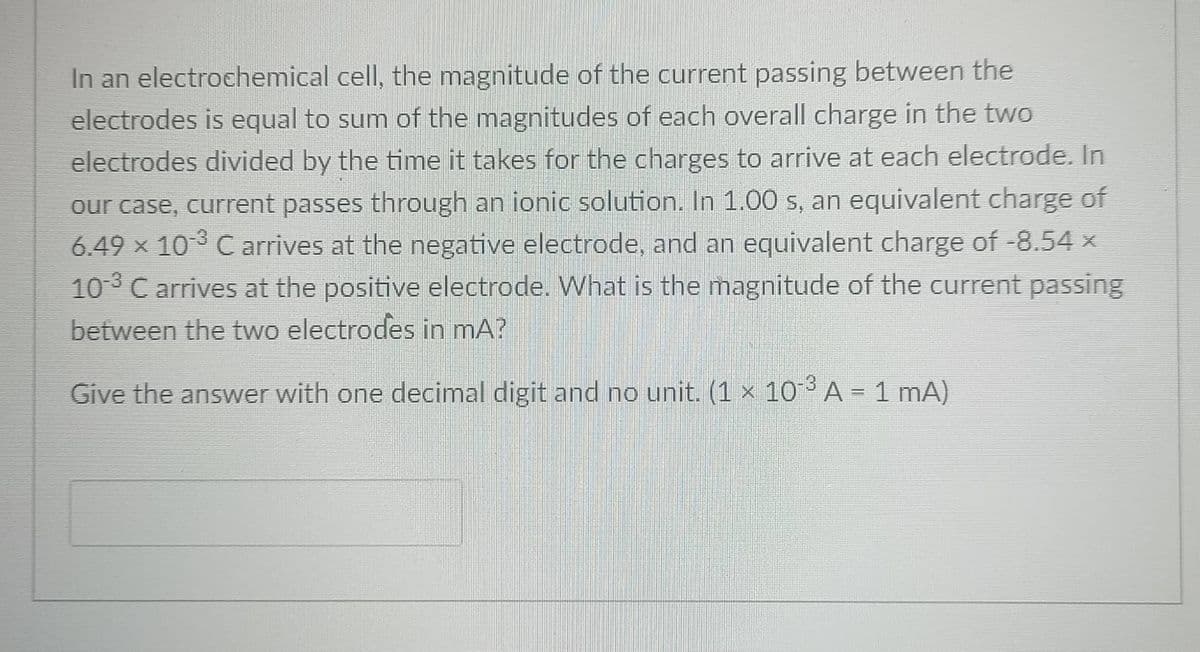In an electrochemical cell, the magnitude of the current passing between the electrodes is equal to sum of the magnitudes of each overall charge in the two electrodes divided by the time it takes for the charges to arrive at each electrode. In our case, current passes through an ionic solution. In 1.00 s, an equivalent charge of 6.49 x 103 Carrives at the negative electrode, and an equivalent charge of -8.54 x 10-3 C arrives at the positive electrode. What is the magnitude of the current passing between the two electrodes in mA? Give the answer with one decimal digit and no unit. (1 x 103 A = 1 mA)
In an electrochemical cell, the magnitude of the current passing between the electrodes is equal to sum of the magnitudes of each overall charge in the two electrodes divided by the time it takes for the charges to arrive at each electrode. In our case, current passes through an ionic solution. In 1.00 s, an equivalent charge of 6.49 x 103 Carrives at the negative electrode, and an equivalent charge of -8.54 x 10-3 C arrives at the positive electrode. What is the magnitude of the current passing between the two electrodes in mA? Give the answer with one decimal digit and no unit. (1 x 103 A = 1 mA)
Chapter9: Current And Resistance
Section: Chapter Questions
Problem 28P: An aluminum wire 1.628 mm in diameter (14-gauge) carries a current of 3.00 amps, (a) What is the...
Related questions
Concept explainers
Ohm's law
Ohm’s law is a prominent concept in physics and electronics. It gives the relation between the current and the voltage. It is used to analyze and construct electrical circuits. Ohm's law states that the voltage across a conductor is directly proportional to the current flowing through it.
Path of Least Resistance
In a series of alternate pathways, the direction of least resistance is the actual or metaphorical route that offers the least resistance to forwarding motion by a given individual or body.
Question
14

Transcribed Image Text:In an electrochemical cell, the magnitude of the current passing between the
electrodes is equal to sum of the magnitudes of each overall charge in the two
electrodes divided by the time it takes for the charges to arrive at each electrode. In
our case, current passes through an ionic solution. In 1.00 s, an equivalent charge of
6.49 × 103 C arrives at the negative electrode, and an equivalent charge of -8.54 x
10-3 C arrives at the positive electrode. What is the magnitude of the current passing
between the two electrodes in mA?
Give the answer with one decimal digit and no unit. (1 × 10 A = 1 mA)
Expert Solution
This question has been solved!
Explore an expertly crafted, step-by-step solution for a thorough understanding of key concepts.
Step by step
Solved in 2 steps

Knowledge Booster
Learn more about
Need a deep-dive on the concept behind this application? Look no further. Learn more about this topic, physics and related others by exploring similar questions and additional content below.Recommended textbooks for you


Principles of Physics: A Calculus-Based Text
Physics
ISBN:
9781133104261
Author:
Raymond A. Serway, John W. Jewett
Publisher:
Cengage Learning

Physics for Scientists and Engineers: Foundations…
Physics
ISBN:
9781133939146
Author:
Katz, Debora M.
Publisher:
Cengage Learning


Principles of Physics: A Calculus-Based Text
Physics
ISBN:
9781133104261
Author:
Raymond A. Serway, John W. Jewett
Publisher:
Cengage Learning

Physics for Scientists and Engineers: Foundations…
Physics
ISBN:
9781133939146
Author:
Katz, Debora M.
Publisher:
Cengage Learning